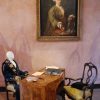Il Portego al primo piano
Questo spazio veniva originariamente usato sia come salone da ricevimento sia come sala passante per accedere agli altri locali, collocati sui due lati. Da qui inizierà la visita nel “teatro di Carlo Goldoni”.
The Sedan Chair
A way of getting around town comfortably and safely
A s a form of transport, the use of litters can be traced back to antiquity: according to Cicero and Juvenal it dates back to the Kings of Bithynia. In its most ancient form, it was used by the Greeks and Romans and was known as a lectica (lectus) – it consisted of a stretcher covered with mattresses and cushions on which the passenger reclined, carried by slaves by means of straps. The type of sedan chair visible here became popular in
England in the second half of the 17th century and its use spread into Italy and France
in the 18th century. It was used for short trips, carried by two porters by means of
two sturdy side poles and consists of a small enclosed cabin with glass windows and
a door for entering. 18th century ladies used chairs to go to ceremonies, or to mass, to take “the air” and to the coffeehouse. Sometimes they even travelled in the chair for shorter journeys. In Venice not only the ladies used them: the Doge descended the golden
staircase of the Doge’s Palace upon a sedan chair in order to board gondolas.
The Fake Patient
Scene from Act Two – scenes 5 and 6
Despite suffering from the pangs of love, Rosaura has not lost her appetite, which she satisfies with figs she hides under her bed behind the backs of her friend Beatrice and her maidservant Colombina, who are worried about her. The scene comprises a daybed in carved wood, a 19th century imitation of an 18th century original; an Adrienne gown, a 20th century replica used as a stage costume; an 18th century silver mirror; a 19th century three-panel folding screen copy of an 18th century original, and four faience pottery apothecary jars (1650ca. – 1749 ca.) The floor features a marble tile with a carved spy hole that allowed the residents of the house to see who was coming into the portego from the canal-side entrance, not too dissimilarly from a present-day peephole.
The Play: Presented successfully during the 1751 carnival season with the title “The apothecary, or The fake patient”, this comedy plays on the comical theme of the Hypochondriac, or imaginary invalid, a recurrent character in stage traditions. From The fake patient, Goldoni created a dramma giocoso which was set to music by F. J. Haydn in 1768.
The Plot: Rosaura, Pantalone’s daughter, is in love with Doctor Onesti and feigns being ill to receive the good doctor’s ministrations, helped in this by her friend Beatrice who, having discovered the secret of her friend’s “illness”, strives to make sure that she is given the “right medicament”. The main obstacle to the success of this design is represented by Doctor Onesti himself who, in spite of his great affection and consideration for Rosaura, has scruples in asking for her hand for fear of being accused of having seduced her during his visits, thus bringing discredit on his honour as a man and a doctor. But everything is eventually solved thanks to Beatrice’s good offices.
The Obedient Daughter
The scene shown here is inspired by Act Two – Scene 4, 5 – 6
Rosaura, who is obliged to obey her father, who has betrothed her to Count Ottavio, decides to inform her suitor Florindo that even though her heart belongs to him, she will abide by her father’s wishes. But how can she get the letter delivered to him? Her friend Beatrice will take matters into her own hands, leading Florindo right into Rosaura’s chamber. The scene in the picture hanging on the wall is from volume 8 of the Pasquali Edition (1761-1766), and has been restaged with an 18th century console table and armchair with characteristics similar to the ones depicted.
The Play: A comedy in three acts, performed for the first time in 1752, Comedy in three acts, represented the first time in 1752, incorporating many of the romantic elements that appealed greatly to the audiences of the time.
The Plot: Florindo, the son of a merchant from Livorno, loves Pantalone’s daughter Rosaura, but when his father gives him permission to marry her, she has already been betrothed by Pantalone to the rich and eccentric Count Ottavio. Florindo’s plight intertwines with the distressed and anguished submission of Rosaura to the agreement her father has entered into with Count Ottavio. Pantalone also suffers, seeing his daughter being sacrificed in this manner. The background action features the affairs of Brighella, a somewhat degenerate father who has become rich due to the success of his daughter Olivetta, a ballerina, from whom a servant is stealing everything but is eventually exposed by Count Ottavio. After various mishaps Count Ottavio decides to release Rosaura from her promise, and she will finally be able to marry her beloved Florindo
Carlo’s portraits
G.B. PIAZZETTA, M.A. PITTERI
Portrait of Carlo Goldoni with cap, 1754 – Etching
This portrait dates back to the very early months of 1754, as can be inferred from the letter dated 17 July 1754, sent by Goldoni to Marco Pitteri. In this letter
the playwright expresses a most sincere appreciation of his work, thanking Pitteri for “the loving care in making me truly eternal with the excellent work of your hands” and also giving a first critical evaluation of it: “Bizarre is this invention of a cap and my natural hair, making the resemblance more constant. The etching is moreover of such worth, that it will place this further work of yours alongside the most esteemed ones by your hand” and in truth, the etching is of the highest quality, characterised by noteworthy vitality and freshness in its engraving and particularly enlivened by the informal cap which conveys a jovial and youthful appearance to the then forty-seven year-old Goldoni. Unfortunately very few prints were made from this etching, because Pitteri altered the copper plate almost immediately, replacing the cap with a wig.
G.B. PIAZZETTA, M.A. PITTERI
Portrait of Carlo Goldoni with wig, 1754 – Etching
This is – in fact – the second version of the portrait with the cap, the cap being substituted by the more formal wig. The reasons that led Pitteri to this decision are not clear; the most credible theory is Bottari’s, who thinks that the
makeover initiative may have been taken autonomously by Pitteri “for having changed his mind”, perhaps wishing to avoid a break from the canons of “dignified” portraiture of the time. The effect of the cap replacement partly worsens
the quality of the engraving, both due to the poor execution of the etched-over section, particularly where the wig hairline joins the forehead, and because in general the portrait lacks freshness, assuming a more formal tone, perhaps less attuned to Goldoni’s personality.
The Venetian Lawyer
The scene shown here is inspired by Act One – Scene 1
Alberto Casaboni, a Venetian lawyer, is at his desk, intent on studying with great concentration a lawsuit in which he is to defend Florindo against Rosaura, a client of Doctor Balanzoni’s and the woman he has fallen in love with.
The staging includes a desk and two small armchairs from the second half of the 18th century; two gilt wood wall mirrors with sconces; a 20th century man’s dressing gown from the Martinuzzi Collection.
On the wall is a portrait of Carlo Goldoni by Alessandro Falca called Longhi from the second half of the 18th century.
The Play:In The Venetian Lawyer, a comedy performed during the 1749-50 theatre season, Goldoni, not forgetting the profession he had practised in Pisa, presents the Venetian lawyer as a positive character, in contrast with theatre tradition which represented men of law as quibbling and meddlesome.
He wrote in his Foreword: “it was most just that I should convey to my much honoured profession that prominence, which rightly becomes it”. The comedy was met with considerable success and was also performed abroad.
Trama: Venetian lawyer Alberto Casaboni is at his desk, intent on studying with great concentration a lawsuit in which he has been called to defend Florindo against Rosaura, a client of Doctor Balanzoni’s. He is torn, as he has feelings for the young woman, whom he happened to see at her balcony. The struggle between duty and passion will end in both virtues being triumphant: Rosaura loses the lawsuit but finds in Alberto a passionate and honest husband.
The Boors
The Play:Written in January 1760 at the end of the Carnival, and first performed at the San Luca theatre in Venice on 16 February with the title La compagnia dei salva deghi (The Cantankerous Men) or I rusteghi (The Boors), the comedy was an immediate success, so that in the 1762 Pasquali edition Goldoni wrote: “I can say that this play is one of my most fortunate ones; because it was well received not only in Venice, but everywhere, where it has been performed so far.”
The Plot: The model of this comedy takes shape in the witty, even somewhat sarcastic, observation of the petty bourgeoisie in its everyday life, a small society with all its contradictions, its merits, its fads and foibles and all its most human impulses. Morbidly attached to the old traditions, four grumpy old men, who recognize unforgettable Sior Lunardo as their leader, stubbornly cling to their conservatism and think and act in an unacceptably old-fashioned way according to their wives, from adorable Siora Felice to silly Marina, and their children, who keep hoping for happier times and are continually disappointed. It will be left to Siora Felice to solve the difficult situation created by the marriage designs involving Lunardo’s daughter and the son of another “boor”, Maurizio, and then, at the end of the comedy, announce the victory of amiability and common sense over grumpiness and obtuseness.
The Surly Benefactor
The Play: Written in French and performed in Paris on 4 November 1771, Le bourru bienfaisant became Il burbero benefico (The Surly Benefactor) in the first translation dated 1772, while the second version, translated by Goldoni himself in 1789, was given the title Il burbero di buon cuore (The Benevolent Curmudgeon).
The Plot: Geronte is a gruff and authoritarian man, but more in appearance than in substance. The fact remains that everyone in the house fears him, including the servants, who however love him and respect him and his two young relatives, niece Angelica and nephew Dalancour. The girl does not dare to confess that she is in love with Valerio, and so Geronte, convinced he is doing right by his niece, promises her in marriage to his friend Dorval. But once the latter finds out about the love the girl feels for Valerio, he withdraws in good order and offers to act as the best man at the young lovers’ wedding. The other nephew, Dalancour, is already married and is on the verge of bankruptcy, even risking prison because of expenses incurred to satisfy his wife’s wishes. Grumpy yet generous, Uncle Geronte ends up settling his nephew’s debts and giving Angelica’s hand in marriage to Valerio.
The Liar
The Play: Written in 1750, The Liar is one of Carlo Goldoni’s most joyous and lively comedies. Inspired by Corneille’s Le Menteur, who in turn based his plot on La Verdad sospechosa by the Spanish playwright Juan Ruiz de Alarcón, Goldoni’s Liar borrows only a small portion of the French author’s subject, giving a new colour and a warmer life to the play. First performed in Mantua in 1750, it was subsequently printed in Florence in 1753.
The Plot: Lelio, Pantalone’s son, returns to Venice from Naples, the city where he grew up, and immediately comes upon a serenade that Florindo, Rosaura’s shy suitor, secretly dedicates to her while she is standing with sister Beatrice on the balcony of her house. Following his nature as an unrepentant liar, Lelio, assisted by his servant Arlecchino, comes forward, attracting the attention of the Doctor’s daughters and attributing the merit of the singing tribute to himself. This is the start of a series of dazzling lies, a game of “witty inventions”, as the imaginative protagonist defines his fibs: he passes himself off as a wealthy Neapolitan noble in love with Rosaura, he even deceives his own befuddled father, who does not recognize him, pretending he is a friend of his own self, and boasts with high-principled Ottavio, Beatrice’s suitor, that he has enjoyed the favours of the two sisters. Even when confronted with the truth, he does not lose heart and quickly changes his story, weaving an even more outlandish web of lies. When, however, his exaggerations reach an unbearable level of immorality, his father and all the others turn from him in disgust, while in the play of theatrical convention the couples of lovers are recomposed.
The chandelier
A gem of luminous manufacturing art
Girasol glass chandelier with applications and flowers in polychrome glass paste. Solid glass arms with bobeches, it was subsequently electrified in the second half of the nineteenth century. While displaying eighteenth-century characteristics, it appears to be of nineteenth-century manufacture, when in fact, various Murano factories produced chandeliers in imitation of seventeenth and eighteenth century models so that it is often difficult to accurately date these pieces.
Downloads
Booklet to visit the Museum
Casa di Carlo Goldoni. La Casa del suo Teatro
![]() – Italiano (PDF 839 Kb) >
– Italiano (PDF 839 Kb) >
– English (PDF 858 Kb) >
– Français (PDF 840 Kb) >











